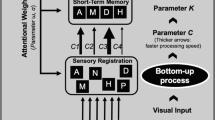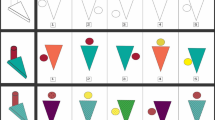Abstract
Recent decades have witnessed a growing interest in intervention-based assessment to promote and enhance children’s learning. In this study, we explored the potential effect of an experimental visual–spatial intervention procedure and possible training benefits of two prompting modalities: one group received training with verbal and visual prompts, a second group training with visual prompts only, while a third, control group did not receive any training. The two training methods led to significant improvements of performance in visuospatial tasks as compared to control group, and they did so about equally well. Our findings provide evidence for the efficiency and benefits of interventions targeting visuospatial processing skills. The success of such interventions does not seem to be bounded by age or gender, and it seems that visual cues are particularly effective.





Similar content being viewed by others
References
Allen, G. L. (2003). Functional families of spatial abilities: Poor relations and rich prospects. International Journal of Testing, 3(3), 251–262.
Archer, A., & Hughes, C. A. (2011). Explicit instruction: Efficient and effective teaching. New York, NY: Guilford Publications.
Assel, M. A., Landry, S. H., Swank, P., Smith, K. E., & Steelman, L. M. (2003). Precursors to mathematical skills: Examining the roles of visual–spatial skills, executive processes, and parenting factors. Applied Developmental Science, 7, 27–38.
Black, P., & Wiliam, D. (1998). Assessment and classroom learning. Assessment in Education, 5(1), 7–74.
Bohning, G., & Althouse, J. K. (1997). Using tangrams to teach geometry to young children. Early Childhood Education Journal, 24(4), 239–242.
Butcher, K. R. (2006). Learning from text with diagrams: Promoting mental model development and inference generation. Journal of Educational Psychology, 98(1), 182–197.
Carr, N. (2008). The big switch: Rewiring the world, from Edison to Google. New York: Norton.
Carr, N. (2010). The shallows: What the internet is doing to our brains. New York: Norton.
Carroll, J. B. (1993). Human cognitive abilities: A survey of factor-analytic studies. Cambridge: Cambridge University Press.
Cheng, Y. L., & Mix, K. S. (2012). Spatial training improves children’s mathematics ability. Journal of Cognition and Development,. doi:10.1080/15248372.2012.725186.
Cortiella, C. (2011). The state of learning disabilities. New York: National Center for Learning Disabilities. Retrieved from http://www.ncld.org/images/stories/OnCapitolHill/PolicyRelatedPublications/stateofld/2011_state_of_ld_final.pdf.
D’Oliveira, T. (2004). Dynamic spatial ability: An exploratory analysis and a confirmatory study. The International Journal of Aviation Psychology, 14, 19–38.
Dehaene, S., Izard, V., Pica, P., & Spelke, E. (2006). Core knowledge of geometry in an Amazonian indigene group. Science, 311, 381–384.
Dye, M. W. G., Hauser, P. C., & Bavelier, D. (2008). Visual skills and cross-modal plasticity in deaf readers: Possible implications for acquiring meaning from print. Annals of the New York Academy of Sciences, 1145, 71–82.
Eliot, J., & Smith, I. M. (1983). An international directory of spatial tests. Windsor Berkshire: NFER-Nelson.
Flanagan, D. P., & Kaufman, A. S. (2004). Essentials of WISC-IV assessment. Hoboken, NJ: Wiley.
Ford, B. E. (2003). Tangrams: The magnificent seven piece puzzle. Vallejo, CA: Tandora’s Box Press.
Foster, T. E. (2007). The legend of the tangram prince. Charleston, SC: BookSurge.
Fuchs, D., & Fuchs, L. (2006). Introduction to response to intervention: What, why, and how valid is it? Reading Research Quarterly, 41, 93–99.
Gardner, H. (1983). Frames of mind: The theory of multiple intelligences. New York: Basic Books.
Gardner, M. F. (1996). Test of visual perceptual skills (n-m) revised. Hydesville, CA: Psychological and Educational.
Grigorenko, E. L. (2009). Dynamic assessment and response to intervention: Two sides of one coin. Journal of Learning Disabilities, 42, 111–132.
Grigorenko, E. L., & Sternberg, R. J. (1997). Styles of thinking, abilities, and academic performance. Exceptional Children, 63(3), 295–312.
Grissmer, D., Grimm, K., Aiyer, S., Murrah, W., & Steele, J. (2010). Fine motor skills and early comprehension of the world: Two new school readiness indicators. Developmental Psychology, 46(5), 1008–1017.
Halpern, D. F. (2012). Sex differences in cognitive abilities (4th ed.). New York: Psychology.
Hattie, J., & Timperley, H. (2007). The power of feedback. Review of Educational Research, 77(1), 81–112.
Haywood, H., & Lidz, C. (2007). Dynamic assessment in practice: Clinical and educational applications. New York: Cambridge University Press.
Hegarty, M., & Just, M. A. (1993). Constructing mental models of machines from text and diagrams. Journal of Memory and Language, 32, 717–742.
Hegarty, M., Keehner, M., Cohen, C., Montello, D. R., & Lippa, Y. (2007). The role of spatial cognition in medicine: Applications for selecting and training professionals. In G. Allen (Ed.), Applied spatial cognition (pp. 285–315). Mahwah, NJ: Lawrence Erlbaum.
Hegarty, M., & Waller, D. (2004). A dissociation between mental rotation and perspective-taking spatial abilities. Intelligence, 32, 175–191.
Hegarty, M., & Waller, D. (2005). Individual differences in spatial abilities. In P. Shah & A. Miyake (Eds.), Handbook of visuospatial thinking (pp. 121–169). New York: Cambridge University Press.
Holmes, J., Adams, J. W., & Hamilton, C. (2008). The relationship between visuo-spatial sketchpad capacity and children’s mathematical skills. European Journal of Cognitive Psychology, 20, 272–289.
Jeltova, I., Birney, D., Fredine, N., Jarvin, L., Sternberg, R. J., & Grigorenko, E. L. (2007). Dynamic assessment as a process-oriented assessment in educational settings. Advances in Speech-Language Pathology, 9, 1–13.
Kalyuga, S., Ayres, P., Chandler, P., & Sweller, J. (2003). The expertise reversal effect. Educational Psychologist, 38(1), 23–31.
Kaufman, S. B. (2007). Sex differences in mental rotation and spatial visualization ability: Can they be accounted for by differences in working memory capacity? Intelligence, 35, 211–223.
Lee, J., Lee, J. O., & Collins, C. (2009). Enhancing children’s spatial sense using tangrams. Childhood Education, 86(2), 92–94.
Linn, M. C., & Petersen, A. C. (1985). Emergence and characterisation of gender differences in spatial abilities: A meta-analysis. Child Development, 56, 1479–1498.
Lohman, D. F. (1988). Spatial abilities as traits, processes, and knowledge. In R. J. Sternberg (Ed.), Advances in the psychology of human intelligence (pp. 181–248). Hillside, NJ: Erlbaum.
Lovett, A., & Forbus, K. (2010). Shape is like space: Modeling shape representation as a set of qualitative spatial relations. Guilford Publications. Proceedings of the AAAI spring symposium on cognitive shape processing. Palo Alto. Retrieved from www.cs.northwestern.edu/~aml758/Papers/ShapeRepresentationComparison.pdf.
Lubinski, D. (2010). Spatial ability and STEM: A sleeping giant for talent identification and development. Personality and Individual Differences, 49, 344–351.
Mathewson, J. H. (1999). Visual–spatial thinking: An aspect of science overlooked by educators. Science Education, 83, 33–54.
Mayer, R. E. (2005). Cognitive theory of multimedia learning. In R. E. Mayer (Ed.), The Cambridge handbook of multimedia learning (pp. 31–48). New York, NY: Cambridge University Press.
Mayer, R. E., & Wittrock, R. C. (2006). Problem solving. In P. A. Alexander & P. H. Winne (Eds.), Handbook of educational psychology (2nd ed., pp. 287–304). Mahwah, NJ: Erlbaum.
Moreno, R. (2010). Cognitive load theory: More food for thought. Instructional Science, 38(2), 135–141.
Moreno, R., & Mayer, R. E. (1999). Cognitive principles of multimedia learning: The role of modality and contiguity. Journal of Educational Psychology, 91(2), 358–368.
National Council of Teacher’s Mathematics. (2003). Developing geometry understandings and spatial skills through puzzle like problems with tangrams: Tangram challenges. Retrieved from www.nctm.org.
National Council of Teachers of Mathematics. (2010). Curriculum focal points for prekindergarten through grade 8: A quest for coherence. Reston, VA: NCTM. Retrieved from www.nctm.org.
National Research Council. (2006). Learning to think spatially: GIS as support system in K-12 curriculum. Washington, DC: National Academies Press.
Newcombe, N. S., & Learmonth, A. E. (2005). Development of spatial competence. In P. Shah & A. Miyake (Eds.), Handbook of visuospatial thinking (pp. 213–256). Cambridge: Cambridge University Press.
Olina, Z., Reiser, R., Huang, X., Lim, J., & Park, S. (2006). Problem format and presentation sequence: Effects on learning and mental effort among U.S. high school students. Applied Cognitive Psychology, 20, 299–309.
Paas, F. G. W. C., Renkl, A., & Sweller, J. (2004). Cognitive load theory: Instructional implications of the interaction between information structures and cognitive architecture. Instructional Science, 32, 1–8.
Paivio, A. (1986). Mental representations: A dual coding approach. Oxford: Oxford University Press.
Passolunghi, M. C., & Mammuarella, I. (2010). Spatial and visual working memory ability in children with difficulties in arithmetic word problem solving. European Journal of Cognitive Psychology, 22, 944–963.
Paul, R. (2007). Language disorders from infancy through adolescence (3rd ed.). St. Louis: Mosby.
Peter, M., Gluck, J., & Beiglbock, W. (2010). Map understanding as a developmental marker in childhood. Journal of Individual Differences, 31, 64–67.
Piaget, J. (1977). In H. E. Gruber & J.J. Vonèche (Eds.), The essential Piaget. New York: Basic Books.
Rasmussen, C., & Bisanz, J. (2005). Representation and working memory in early arithmetic. Journal of Experimental Child Psychology, 91, 137–157.
Raven, J., Raven, J. C., & Court, J. H. (1998, updated 2003). Manual for Raven’s Progressive Matrices and Vocabulary Scales. San Antonio, TX: Harcourt Assessment.
Resing, W. C. M., & Elliott, J. G. (2011). Dynamic testing with tangible electronics: Measuring children’s change in strategy use with a series completion task. British Journal of Educational Psychology, 81, 579–605.
Resing, W. C. M., Steijn, W. M. P., Xenidou-Dervou, I., Stevenson, C. E., & Elliott, J. G. (2011). Dynamic testing with an electronic console: Do children listen to the computer? Journal of Cognitive Education and Psychology, 10(2), 178–194.
Schnotz, W., & Kurschner, C. (2007). A reconsideration of cognitive load theory. Educational Psychology Review, 19(4), 469–508.
Shute, V. J. (2008). Focus on formative feedback. Review of Educational Research, 78(1), 153–189.
Slocum, J., Botermans, J., Gebhardt, D., Ma, M., Ma, X., Raizer, H., et al. (2003). The tangram book. New York: Sterling Publishing Co.
Soderstrom, N. C., & Bjork, R. A. (in press). Learning versus performance. In D. S. Dunn (Ed.), Oxford bibliographies online: Psychology. New York: Oxford University Press. Retrieved from http://bjorklab.psych.ucla.edu/pubs/Soderstrom_Bjork_Learning_versus_Performance.pdf.
Sophian, C. (2000). Perceptions of proportionality in young children: Matching spatial ratios. Cognition, 75, 145–170.
Sternberg, R. J., & Grigorenko, E. L. (2002). Dynamic testing: The nature and measurement of learning potential. New York: Cambridge University Press.
Sternberg, R. J. (2003). Contemporary theories of intelligence. In W. M. Reynolds & G. E. Miller (Eds.), Comprehensive handbook of psychology: Educational psychology (Vol. 7, pp. 23–46). New York: Wiley.
Sutton, K. J., & Williams, A. P. (2007). Spatial cognition and its implications for design. Hong Kong: International Association of Societies of Design Research.
Terlecki, M. S., Newcombe, N. S., & Little, M. (2008). Durable and generalized effects of spatial experience on mental rotation: Gender differences in growth patterns. Applied Cognitive Psychology, 22, 996–1013.
Tzuriel, D., & Egozi, G. (2010). Gender differences in spatial ability of young children. Child Development, 81, 1417–1430.
Uttal, D. H., Meadow, N. G., Tipton, E., Hand, L. L., Alden, A. R., Warren, C., et al. (2012). The malleability of spatial skills: A meta-analysis of training studies. Psychological Bulletin,. doi:10.1037/a0028446.
Van Garderen, D., & Montague, M. (2003). Visual–spatial representation, mathematical problem solving, and students of varying abilities. Learning Disabilities Research & Practice, 18, 246–254.
Van Hiele, P. M. (1983). Structure and insight. Dordrecht: Kluwer Academic.
Wai, J., Lubinski, D., & Benbow, C. P. (2009). Spatial ability for STEM domains: Aligning over fifty years of cumulative psychological knowledge solidifies its importance. Journal of Educational Psychology, 101, 817–835.
Webb, R. M., Lubinski, D., & Benbow, C. P. (2007). Spatial ability: A neglected dimension in talent searches for intellectually precocious youth. Journal of Educational Psychology, 99, 397–420.
Willcutt, E. G., Doyle, A. E., Nigg, J. T., Faraone, S. V., & Pennington, B. F. (2005). Validity of the executive function theory of attention-deficit/hyperactivity disorder: A meta-analytic review. Biological Psychiatry, 57, 1336–1346.
Author information
Authors and Affiliations
Corresponding author
Rights and permissions
About this article
Cite this article
Chabani, E., Hommel, B. Effectiveness of visual and verbal prompts in training visuospatial processing skills in school age children. Instr Sci 42, 995–1012 (2014). https://doi.org/10.1007/s11251-014-9316-7
Received:
Accepted:
Published:
Issue Date:
DOI: https://doi.org/10.1007/s11251-014-9316-7




